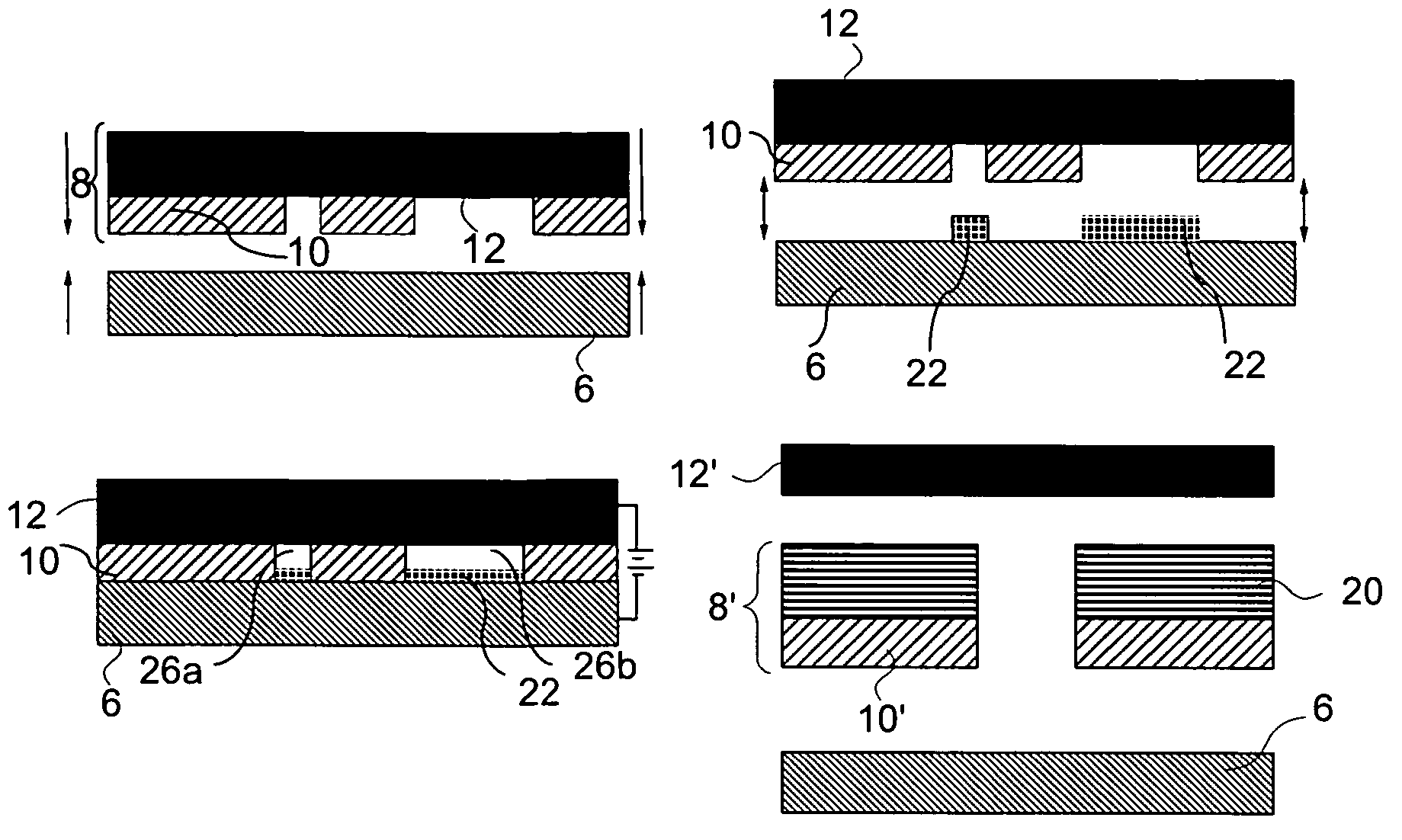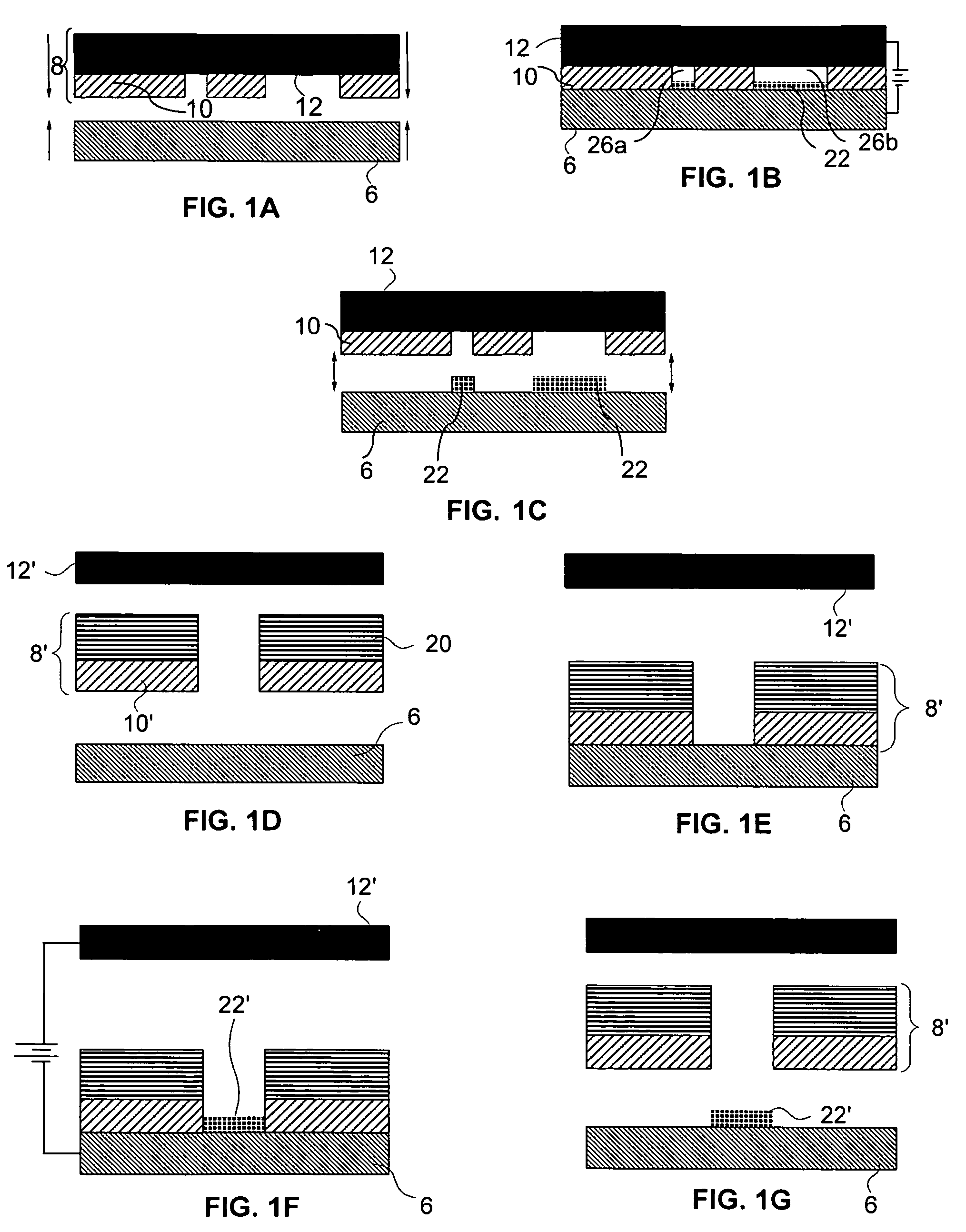Method for electrochemically forming structures including non-parallel mating of contact masks and substrates
a technology of contact masks and substrates, applied in the field of electrochemical fabrication and the associated formation of three-dimensional structures, can solve the problems of destructive separation of masking materials from substrates, and achieve the effect of improving the mating of masks and substrates
- Summary
- Abstract
- Description
- Claims
- Application Information
AI Technical Summary
Benefits of technology
Problems solved by technology
Method used
Image
Examples
first embodiment
[0087]FIGS. 6A-6F depict schematic side views that define a non-parallel mating operation and non-parallel un-mating operation that may be used together or separately in accordance with the invention where the mask support is substantially inflexible.
[0088]FIG. 6A depicts a side view of a substrate 202 to which a contact mask 204 is to be mated by moving in the direction indicated by arrow 206. Substrate 202 has a contact or mating surface 212 while mask 204 has a contact or mating surface 214 which is defined by a pattern of protruding elements (not shown).
[0089]FIG. 6B shows the state of the process after substrate 202 and mask 204 have been brought into initial contact along their left most edges. If the mating surface of mask 204 includes a conformable material, a line of mating will progress from the left most side of the mask and substrate toward their right side most sides as continued relative motion of the mask and substrate occurs. Until the point is reached where mating i...
second embodiment
[0093]FIGS. 7A-7F depict schematic side views that define a non-parallel mating operation and non-parallel un-mating operation that may be used together or separately in accordance with the invention where the mask support is flexible.
[0094]FIG. 7A depicts a schematic side view of an initial state of the mating process where a mask 304 and a substrate 302 are separated by a distance. Substrate 302 has a contact surface 312 which is substantially planar while mask 304 has a contact surface 314 that is curved, bent or otherwise flexed to a convex shape. It is intended that arrow 306 indicate that the mask and the substrate are being brought together using a substantially translational motion. In other embodiments rotational motion may be used alone or in combination with translation motion to cause mating of the mask and substrate surfaces.
[0095]FIG. 7B depicts a schematic side view of the state of the process after mask 304 and substrate 302 have made initial contact at their left mo...
third embodiment
[0103]FIGS. 8A-8G define a non-parallel mating operation that may be used in accordance with the invention where the mask support is flexible and the mask is flexed along two axes.
[0104]FIG. 8A schematically depicts a side view of a mask 404 while it is in a substantially planar state, while FIG. 8B, on the other hand, schematically depicts a side view of mask 404 while it is being flexed to have a substantially convex shape in the downward direction. In particular, both left and the right portions of the mask are depicted in FIG. 8B as being raised above the central portion of the mask.
[0105]FIG. 8C depicts a top view of the curved mask of FIG. 8B where equal height contour lines in z are shown to be circles. Circle 412 represents a position lower than that of circle 414 which represents a position lower then that of mask surface elements located along contour line 416. Circles 418 and 420 depict still higher equal height contour lines along the mask surface.
[0106]FIG. 8D schematic...
PUM
| Property | Measurement | Unit |
|---|---|---|
| diameters | aaaaa | aaaaa |
| diameters | aaaaa | aaaaa |
| diameters | aaaaa | aaaaa |
Abstract
Description
Claims
Application Information
 Login to View More
Login to View More - R&D
- Intellectual Property
- Life Sciences
- Materials
- Tech Scout
- Unparalleled Data Quality
- Higher Quality Content
- 60% Fewer Hallucinations
Browse by: Latest US Patents, China's latest patents, Technical Efficacy Thesaurus, Application Domain, Technology Topic, Popular Technical Reports.
© 2025 PatSnap. All rights reserved.Legal|Privacy policy|Modern Slavery Act Transparency Statement|Sitemap|About US| Contact US: help@patsnap.com



